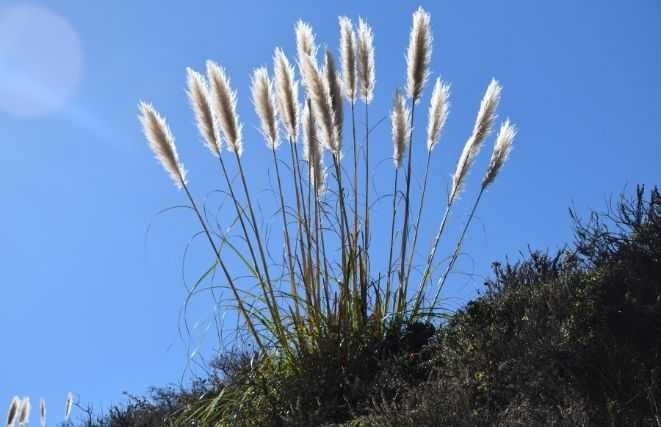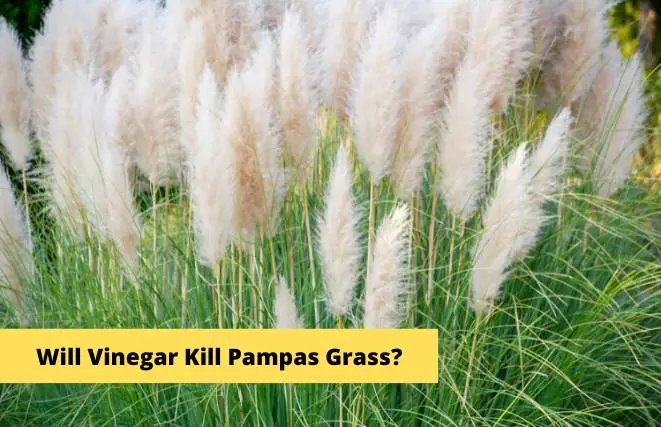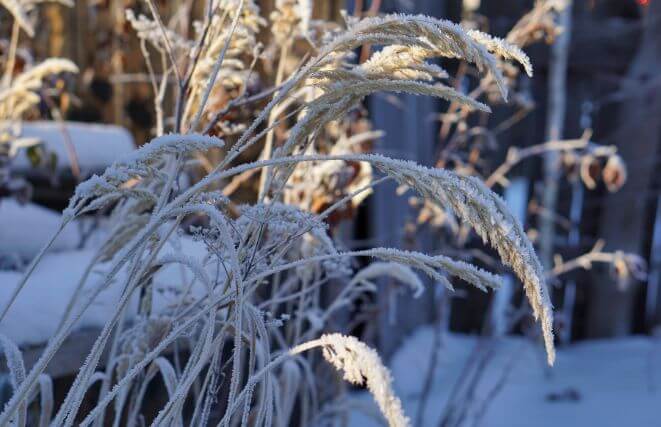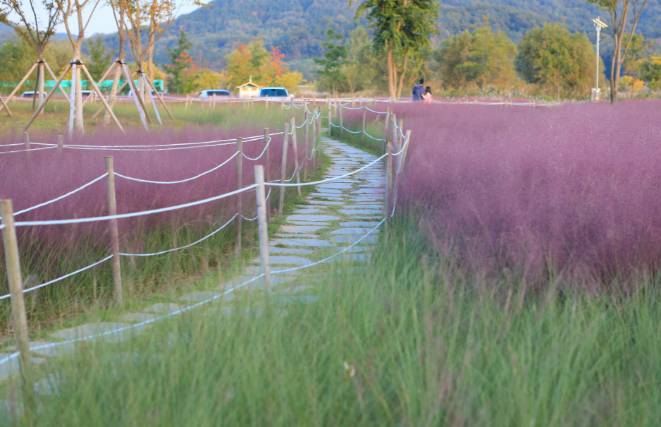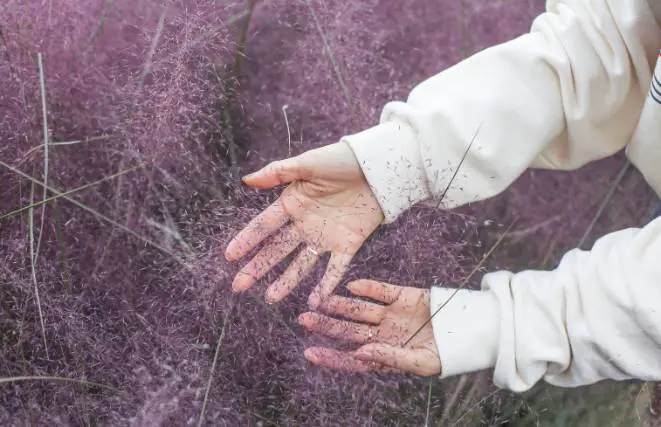Hardy pampas grass refers to cultivars or varieties of pampas grass that are able to tolerate colder temperatures and harsher winter conditions than the typical pampas grass.
Some hardy pampas grass cultivars have been developed specifically for colder regions and can survive in USDA hardiness zones 6 or even 5, where temperatures can drop well below freezing. These cultivars are often bred for their ability to produce shorter, sturdier stems and better cold tolerance.
Examples of hardy pampas grass cultivars include ‘Pumila’, ‘Sunningdale Silver’, ‘Silver Fountain’, and ‘Andes Silver’. These cultivars are known for their hardiness, drought tolerance, and large, showy plumes.
It’s important to note that even hardy pampas grass may still require some winter protection in colder regions. You can help protect the plant by cutting back the foliage in the fall and covering the base of the plant with a layer of mulch or straw. Additionally, planting in a sheltered location and providing some winter protection can help ensure the success of hardy pampas grass in colder regions.
What Is Hardy Pampas Grass?
Hardy pampas grass is the common name for a species of grass native to southern Europe and the Mediterranean. This distinguishes it from true pampas grass, which is native to Brazil. You should also take note of the scientific name of Hardy pampas grass, Erianthus ravennae, and that it is also called Ravenna grass or plume grass.
A fully-flowered shrub of this species can grow up to 10 feet tall, making it one of the tallest grasses in the world. The height of the foliage, excluding the fall-time light and feathery plumes or flowers, can extend from 8 feet to 10 feet. The grass’s spread can be anywhere from 4 feet to 6 feet. Flower stalks start to pop out around fall in late September to late October.
| Common Name | Hardy Pampas Grass |
| Scientific Name | Erianthus ravennae |
| Height & Spread | 6-10 ft tall and 4-6 ft wide |
| Sun Exposure | Full sun to partial shade |
| USDA Growing Zones | Zones 5-9 |
| Water | Low to moderate watering |
| Soil Type | Well-drained soil |
| Soil pH | 6.0-7.5 |
| Pests & Diseases | Susceptible to rust and fungal diseases |
| Bloom Time | Late summer to early fall |
| Flower Color | Silvery white to pinkish plumes |
| Native Area | Southern Europe, Western Asia |
When to Plant Hardy Pampas Grass?
Hardy pampas grass is typically best planted in the early spring or early fall.
These seasons provide the most favorable conditions for the establishment and growth of the plant.
- Spring Planting: Planting pampas grass in the spring allows it to take advantage of the warming temperatures and longer days. It gives the plant a chance to establish its roots before the summer heat sets in. Aim to plant in the spring after the last frost has passed and the soil has started to warm up.
- Fall Planting: Fall planting is also a suitable option for hardy pampas grass. Planting in the fall allows the grass to take advantage of the cooler temperatures and ample rainfall. The plant has time to establish its root system before the onset of winter dormancy. Aim to plant in the early fall, giving the roots enough time to settle in before the ground freezes.
It’s important to note that pampas grass prefers well-draining soil and full sunlight. Before planting, prepare the soil by loosening it and removing any weeds or grass. Dig a hole that is wide and deep enough to accommodate the root ball of the plant. Place the pampas grass in the hole, backfill with soil, and water thoroughly.
Pampas grass is more commonly planted in areas with mild winters and moderate to warm summers. If you live in an area with harsh winters or extreme heat, it’s advisable to consult with local gardening experts or horticultural resources to determine the best time for planting hardy pampas grass in your specific location.
When to Prune Hardy Pampas Grass
Pruning is an essential task in maintaining the health and appearance of hardy Pampas Grass. Knowing when to prune this ornamental grass can ensure its longevity and promote optimal growth.
Ideally, pruning hardy Pampas Grass should be done during late winter or early spring, before new growth begins. This timing allows for the removal of dead or damaged foliage from the previous growing season while giving the plant ample time to recover and regrow before its active growth period.
When pruning hardy Pampas Grass, it is important to wear protective gloves and clothing due to its sharp leaves. Begin by cutting back the grass to a height of about 6-12 inches above ground level using sharp pruning shears or a power trimmer. Be sure to remove any dead or browned-out foliage as well.
It’s worth noting that if you live in an area with mild winters, where hardy Pampas Grass remains green throughout the year, you may choose to prune it in late fall instead. This timing allows for better visual appeal during the winter months while still allowing sufficient time for new growth before spring arrives.
Regular pruning helps prevent overgrowth and promotes a more compact and aesthetically pleasing appearance for hardy Pampas Grass. By following these guidelines on when to prune, you can ensure that your grass remains healthy and vibrant year after year.
Main Uses
These grass species are popularly used for decoration and are commonly called ornamental grasses. The majestic towering height and beautiful white flowers are very attractive. If you have enough space in your yard, these ornamental grasses can make the perfect central attraction.
Hardy pampas grass (common name) is not only used as ornamental grass, but its height and thick leaves also make it suitable as a green privacy screen or hedge. If you prefer a dry specimen, you can use this for floral arrangements. Feel free to use both fresh and dried flowers.
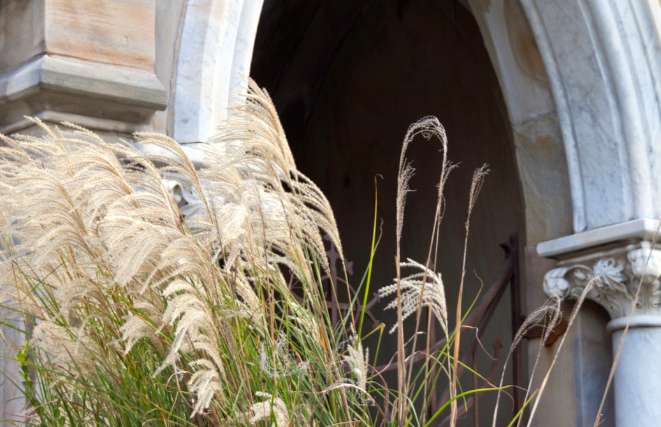
Hardy pampas grass care
Hardy pampas varieties may be acceptable in some places. If you are in a region where propagation is not illegal and the weather is ideal, you might need some tips about growing the grass. These grasses are drought resilient. Some of the other advantages of this ornamental grass include attracting birds to the flower parts, being easy to grow, deer resistance, and winter interest.
Growing Zones
These grasses grow best in USDA Zones 6- 9. They prefer warmer regions, but if you choose to grow them in a colder area such as Zone 4, it’s best to do so in a large flower container. You can keep them outdoors to receive as much sun as possible during the summer, spring, and fall seasons. When fall ends and the cold winter months roll around, it’s advisable to carry the flowerpot into a warmer indoor location, when possible. The size and space requirements of the full-grown grass make can make it challenging for those growing the plant in Zone 4 and other cold regions.
Water Requirements
With this pampas species, in particular, only average water is required, and the soil should be well-drained. Partially sandy soil is ideal. This is a drought-resistant plant.
Soil Conditions
When it comes to choosing which soil to grow your pampas plant specimen in, it is best to select a well-drained one.
Sunlight Conditions
These tall ornamental grasses grow best in the full light of the sun. Its structure need not be sheltered or shaded by trees or roofs for optimal growth.
Flower Seasonality
As a hardy pampas grass, Erianthus ravennae is great all year round where foliage is concerned. This perennial plant stands tall in springtime, summer, fall, and winter. The bloom time for the characteristic light and feather-like white flowers is from late summer to early fall.
Propagation
The most common way to propagate specimens of this tall hardy grass is by division during the spring season.
Pruning
The thick leaves of the tall grass can take up a very wide area. You should fall into the habit of pruning them down annually to keep them in check. Spring is one of the best times for pruning this drought-tolerant plant. The simplest way you can do this is using some sharp shears or a saw. To protect yourself, you should make it a habit to wear gloves and long sleeves during pruning the grass. Hardy pampas varieties can cut you if not.
Doing this during the springtime leaves enough time for the tall grass to recover and produce more flowers when the next late summer and fall come around.
Hardy Pampas Grass Zone 5
Pampas grass (Cortaderia selloana) is typically hardy in USDA Hardiness Zones 7 to 11. However, there are some cold-hardy cultivars available that can tolerate Zone 5 climates with proper care. It’s important to note that even these cold-hardy varieties may require some winter protection in Zone 5. Here are a few pampas grass cultivars that have shown some degree of tolerance to colder climates:
- ‘Pumila’: This dwarf pampas grass cultivar is known for its compact size, reaching around 4 to 6 feet in height. It has demonstrated better cold hardiness compared to other pampas grass varieties and can sometimes survive in Zone 5 with winter protection.
- ‘Silver Feather’: This pampas grass cultivar is prized for its silver-white plumes and upright growth habit. While it is more commonly grown in warmer zones, it has shown some tolerance to Zone 5 climates when provided with adequate protection during the winter months.
- ‘Sunningdale Silver’: This cold-hardy pampas grass cultivar features large, fluffy plumes with silver-white coloration. It can reach heights of 6 to 8 feet and has demonstrated better cold tolerance compared to some other varieties.
Hardy pampas grass zone 5 care
When growing pampas grass in Zone 5, it’s important to provide it with a well-drained soil, full sun exposure, and protection from harsh winter winds. Applying a thick layer of mulch around the base of the plant and wrapping it with burlap or protective coverings can help insulate it from extreme cold temperatures. It’s also advisable to consult with local nurseries or gardening experts in your area for specific cultivars that have proven successful in Zone 5 conditions.
Hardy pampas grass zone 5 height
In Zone 5 climates, hardy pampas grass (Cortaderia selloana) typically reaches a height of approximately 6 to 10 feet (1.8 to 3 meters) when fully mature. However, the exact height can vary based on factors such as local climate conditions, soil quality, and care. This grass is known for its tall and feathery plumes, making it a striking addition to gardens in Zone 5 when it reaches its full height.
When to Seed Hardy Pampas Grass
Hardy Pampas Grass can be propagated from seeds, but it’s important to note that germination can be challenging and slow. If you decide to start Pampas Grass from seeds, here are some guidelines:
- Timing: The optimal time to sow Pampas Grass seeds is in the late spring or early summer when the soil temperatures are consistently warm. This usually falls between April and June in most regions. Starting the seeds indoors 8 to 10 weeks before the last expected frost can also be a viable option.
- Germination Conditions: Pampas Grass seeds require specific conditions for successful germination. The seeds benefit from scarification, which involves nicking or lightly scratching the seed coat to enhance germination. Soaking the seeds in warm water overnight before sowing can also improve germination rates.
- Soil Preparation: Prepare a well-draining seed-starting mix or use a light soil medium. Pampas Grass prefers sandy or loamy soils. Ensure the soil is moist but not waterlogged.
- Sowing the Seeds: Plant the Pampas Grass seeds in shallow furrows or press them gently into the soil surface. Lightly cover the seeds with a thin layer of soil or vermiculite, as they require light to germinate.
- Germination Process: Place a clear plastic cover or plastic wrap over the planting container to create a greenhouse-like environment that retains moisture. Keep the soil consistently moist but not saturated. It may take several weeks or even months for the seeds to germinate, so patience is key.
- Transplanting: Once the seedlings have grown to a suitable size, typically with two or more sets of true leaves, they can be transplanted into their permanent location in the garden. Ensure that the planting area provides ample space for the mature size and spread of Pampas Grass.
How Deep is the root system of Hardy Pampas Grass?
The root system of Hardy pampas grass can extend quite deep into the soil. On average, the roots of pampas grass can penetrate the ground to a depth of 3 to 6 feet or more, depending on the soil conditions and available water.
Pampas grass is known for its vigorous growth and adaptability, and its extensive root system plays a crucial role in providing stability and access to nutrients and water. The deep roots help the plant withstand harsh conditions, including drought and strong winds.
When planting pampas grass, it’s important to consider its deep-rooted nature. Ensure that you provide enough space for the roots to spread out and establish. Dig a hole that is wide and deep enough to accommodate the root ball, ensuring that the roots are not cramped or restricted.
The deep root system of pampas grass can make it challenging to remove or transplant once established. If you plan to plant pampas grass, choose the location carefully, as it can be difficult to control and remove if it becomes invasive or unwanted.
How Wide does Hardy Pampas Grass Grow?
Hardy Pampas Grass (Cortaderia selloana) can have a wide growth habit, with the spread of the plant varying depending on its specific cultivar, growing conditions, and available space. On average, the mature clumps of hardy Pampas Grass can have a spread ranging from 4 to 6 feet in diameter. However, in optimal conditions, some cultivars can develop even larger clumps with a spread exceeding 8 feet.
It’s important to consider the potential size and spread of Pampas Grass when planning its placement in your landscape or garden. Make sure to provide adequate space to accommodate its growth without overcrowding other plants or structures. Regular maintenance, such as dividing and thinning out the clumps, may be necessary to control the spread and keep the plant in check.
Is Hardy Pampas Grass invasive?
Yes, Hardy pampas grass (Cortaderia selloana) can be considered invasive in some regions. Native to South America, pampas grass has been introduced to various parts of the world as an ornamental plant. Its ability to spread rapidly and establish dense stands makes it a concern in certain ecosystems.
Pampas grass can outcompete native vegetation, disrupt natural habitats, and alter ecological processes. Its large plumes produce numerous seeds that are easily dispersed by wind, water, or human activity. These seeds can germinate and establish new plants, leading to the expansion of pampas grass populations.
To prevent the invasive spread of pampas grass, it is important to exercise caution when planting it. In regions where it is considered invasive, it is generally recommended to avoid planting pampas grass altogether or to choose non-invasive alternatives for landscaping purposes.
If pampas grass is already present in an area where it is considered invasive, it may require management strategies such as regular cutting, controlled burning, or the application of herbicides to control its spread and reduce its impact on native ecosystems.
How Fast Does Hardy Pampas Grass Grow?
This type of hardy winter interest grass grows at a rate of 2 to 3 feet per year under ideal conditions. As long as it is in the right growing region and has lots of natural light and well-drained soil, you can expect the plant to shoot from 6 feet all the way up to 12 feet or even 14 feet in some cases within no time. It can take anywhere from 2 to 4 years for the tall grass to reach full maturity. If you need a privacy screen, then this fast-growing species may be worth investing in.
Potential landscaping uses
Hardy Pampas Grass (Cortaderia selloana) offers various landscaping uses due to its size, hardiness, and attractive plumes. Here are some potential landscaping uses for Hardy Pampas Grass:
- Privacy Screens: Planting Hardy Pampas Grass in a row can create a natural privacy screen or windbreak, thanks to its tall and dense growth habit. The feathery plumes add an elegant touch while providing privacy and reducing noise.
- Focal Points: Due to its impressive height and striking appearance, Hardy Pampas Grass can serve as a captivating focal point in your landscape design. Plant it as a standalone specimen in an open space to draw attention and add visual interest.
- Borders and Edging: Use Hardy Pampas Grass to define borders or edges in your garden or landscape beds. The tall plumes create a soft and textured border that adds dimension to your outdoor space.
- Erosion Control: The extensive root system of Pampas Grass helps stabilize soil and prevent erosion on slopes or areas prone to erosion. Planting it strategically can help protect vulnerable areas and add beauty at the same time.
- Natural Landscapes: If you have a large property or want to create a natural landscape, Hardy Pampas Grass can be incorporated into meadow or prairie-style plantings. Its tall, grassy presence adds a touch of wildness and enhances the natural aesthetics.
Remember to consider the mature size and growth habit of Hardy Pampas Grass when planning its landscaping uses, as it can spread and take up considerable space.
Hardy Pampas Grass for Sale
Growing your specimens can be a lot of fun if gardening is a pastime and habit you enjoy. It is best to plant the grass 6 feet to 8 feet apart to give room for the spread. These plants can grow out by a few feet or up to 8 feet when fully mature. When the summer and fall arrive, it’s time to start cutting the white flowers to take indoors or dry. You can buy the small and light grass seeds online and start your own plants and flowers from scratch.
If you prefer to buy dried pampas grass to include in your flower arrangements, then you can buy it online as well. Its beautiful white flowers make it the perfect addition to a home or office for a clean and sophisticated look. You can also look into other varieties with pink flowers if you prefer.
Hardy Pampas Grass FAQ
Pampas grass is quite resilient to harsh weather conditions. It usually grows in USDA zones 6, 7, 8, and 9. Zone 4 or 5 might be too cold. It prefers full sun, but it is also classed as a winter interest species. In colder areas, the grasses can still be grown, but it is recommended that you place them in containers and bring these indoors after the fall during the winter months.
As lovely as this ornamental grass is, there is a downside too. It is illegal in some parts of the world because of the aforementioned invasive behavior. The grass is called a noxious weed in Australia because it can threaten the natural environment and other plant species. For that reason, the country forbids its locals from the sale of such grasses.
Pampas grass is also illegal in other parts of the world with various restrictions on selling and growing the hardy plant. These places include South Africa, New Zealand, and Hawaii.
Conclusion
The Hardy Pampas grass (Erianthus ravennae) is one of the most eye-catching ornamental grasses. This tall species fills up space where it is grown without any difficulty, spreading anywhere from a few feet to 8 feet across. This makes it perfect as a decorative flower plant or privacy screen.
Towards the late summer months and the beginning of the fall season, the white or light pink flowers start to come out for you to enjoy. There’s a lot to love about these tall hardy plants, but you also have to pay attention to their large size and invasive behavior.

